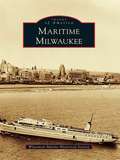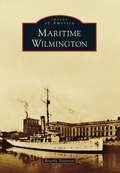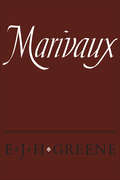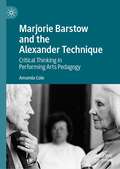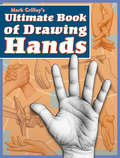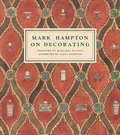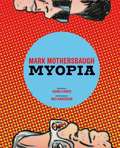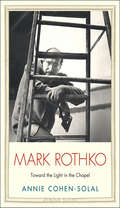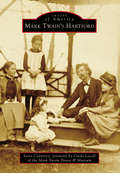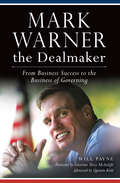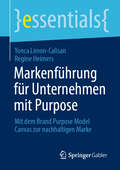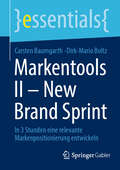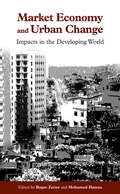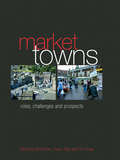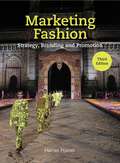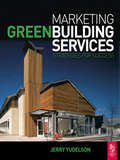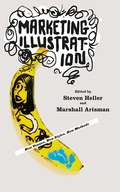- Table View
- List View
Maritime Milwaukee
by Wisconsin Marine Historical SocietyIn 1778, the first sailing vessel with cargo holds, the Archange, a schooner built for prominent British trader John Askin, found "quiet waters" in Milwaukee Bay. These quiet waters and the Milwaukee, Menomonee, and Kinnickinnic Rivers made Milwaukee a favorable destination for early settlers. Maritime Milwaukee explores the growth of the city's port and three riverfronts through a variety of photographs spanning the 1800s to the present thanks to the archival preservation of collections by the Port of Milwaukee, the Milwaukee Public Library, and the Wisconsin Marine Historical Society.
Maritime Olympia and South Puget Sound (Images of America)
by John W. Hough Les EldridgeThis engaging pictorial history traces the evolution of South Puget Sound from the provider of rich resources for the First Nations to Olympia’s role as an important international seaport. The estuary was named Puget’s Sound after Lt. Peter Puget, of British captain George Vancouver’s 1792 exploration of the region. The capital city of Olympia was a frequent stop for Mosquito Fleet steamers a century ago and has evolved into a major port for the worldwide export of timber. Today, people enjoy Olympia as a vibrant, modern seaport with many recreational opportunities.
Maritime Wilmington
by Beverly TettertonIncorporated in 1739 on the east bank of the Cape Fear River, Wilmington lies 28 nautical miles from the Atlantic Ocean. The city grew to become the largest in the state before the Civil War, and it remained so until the second decade of the 20th century. In 1840, Wilmington became the terminus of the state's first railroad, and the port grew dramatically. From the Civil War until World War I, naval stores, cotton, and fertilizer were the major reasons for ships to call from all over the world. Since 1789, a US Coast Guard cutter has been docked in Wilmington on the government wharf in front of the US Custom House. People began to look to the river as a place of recreation after the US Battleship North Carolina found a permanent berth on the west side of the river in 1961. What was once a busy harbor is now a scenic draw for tourists and locals who enjoy visiting the old city.
Marivaux
by E. J. GreeneThe last thirty years have seen a renewed interest in the novels, plays, and essays of Marivaux. Each year more of his work is made available to the public in partial editions. More and better studies have appeared, superseding the old and, in the last thirty years, almost all of his plays have been performed. Today no corder of his work remains unexplored: our knowledge of his life, which had been until recently a tissue of fancy and anecdote, has been enhanced by the discovery of a few facts. This critical study of the entire body of Marviaux's writings sets out to tell whether this attention represents a securely established place for Marivaux among the great French writers, or simply a vogue. It consists of a careful analysis of the individual works, in chronological order rather than in systematic groups, as is customary, showing the development of Marivaux's thinking, and the intimate relationship among the plays, novels, and essays of any given period. A history of the reception of the works, by scholars and critics from Marivaux's time to the present, presents succinctly the historical perspective through which the modern reader may understand the long indifference to Marivaux in France and his contemporary "discovery." Professor Greene's work will be of great value to all students of the eighteenth century in France. Because of his lively interest in the theatre arts it will also be valuable for directors planning to produce the plays of Marivaux.
Marjorie Barstow and the Alexander Technique: Critical Thinking in Performing Arts Pedagogy
by Amanda ColeThis book focuses on the teaching and philosophy of the pioneering performing arts teacher and educator Marjorie Barstow. She is one of the best and brightest exponents of the Alexander Technique (AT), an approach to awareness and movement widely deployed and valued in the performing arts and outside artistic circles. By comparing her approach to the educational philosophy of John Dewey, this book resurrects Marjorie Barstow’s name, and gives her pedagogy and legacy the attention it deserves.
Mark Crilley's Ultimate Book of Drawing Hands
by Mark CrilleyDiscover the simple secrets to drawing amazing hands, from popular YouTube instructor Mark CrilleyWhether you&’re drawing superheroes, manga and anime characters, robots, highly detailed photorealistic figures or anything in between, hands can be the most challenging aspect of creating compelling characters that gesture, communicate, and truly come to life. In simple step-by-step lessons along with plenty of full-color examples, popular instructor and author Mark Crilley takes you from the basics to the finer points. All you need is paper, pencil, and eraser.
Mark Hampton On Decorating
by Alexa Hampton Mark Hampton Margaret RussellWhen On Decorating was published in 1989, it immediately became a touchstone for design profesionals and enthusiasts. Since then, the ideas and illustrations within these pages have inspired countless room schemes, vignettes, and color palettes. Mark Hampton's expert insights into the creation of elegant rooms, and his remarkably immediate voice, remain just as relevant today.Posthumously celebrated by Architectural Digest as "one of the wold's twenty greatest designers of all time," Hampton regarded every design project as a collaboration. That same generosity of spirit pervades this book, offering signature principles that can easily be applied to any home. In the Colors section, Hampton makes a convincing case fo using dark green as a neutral, and encourages readers not to fear painting walls red. In Plans, he explains the keys to arranging a living room that telegraphs comfort, not just refinement. In Materials, Hampton demonstrates how strongly patterned wallpaper can visually enlarge a small space, contrary to popular belief.Throughout this colleciton of essays, which were substantially expanded from his popular House & Garden columns, Hampton shares witty anecdotes and observations that render this education in home decoration a delight. Faithfully reproduced with his original, often-emulated watercolor illustrations and with an afterword by his duaghter, reowned designer Alexa Hampton, this beautiful reprint edition is a book to pore over, savor, and share.
Mark Mothersbaugh
by Adam Lerner Wes AndersonMark Mothersbaugh is a legendary figure for fans of both street art and music culture. Cofounder of the seminal New Wave band DEVO, he was a prolific visual artist before the band's inception moving seamlessly between multiple mediums creating bold, cartoonish, strangely disturbed works of pop surrealism that playfully explore the relationship between technology and individuality. In the most comprehensive presentation of his work to date, Mark Mothersbaugh: Myopia features a lifetime of his creative inventions from the beginning of his artistic career in the 1970s to his most recent work, including early postcards, screen prints, decals, and DEVO ephemera as well as later paintings, photographs (such as the celebrated Beautiful Mutants series), sculpture, and rugs. Accompanied by a major six city traveling exhibition, this richly illustrated catalog positions Mothersbaugh as a pivitol figure in the history of both contemporary art and indie culture.
Mark Rothko
by Annie Cohen-SolalMark Rothko, one of the greatest painters of the twentieth century, was born in the Jewish Pale of Settlement in 1903. He immigrated to the United States at age ten, taking with him his Talmudic education and his memories of pogroms and persecutions in Russia. His integration into American society began with a series of painful experiences, especially as a student at Yale, where he felt marginalized for his origins and ultimately left the school. The decision to become an artist led him to a new phase in his life. Early in his career, Annie Cohen-Solal writes, "he became a major player in the social struggle of American artists, and his own metamorphosis benefited from the unique transformation of the U.S. art world during this time." Within a few decades, he had forged his definitive artistic signature, and most critics hailed him as a pioneer. The numerous museum shows that followed in major U.S. and European institutions ensured his celebrity. But this was not enough for Rothko, who continued to innovate. Ever faithful to his habit of confronting the establishment, he devoted the last decade of his life to cultivating his new conception of art as an experience, thanks to the commission of a radical project, the Rothko Chapel in Houston, Texas. Cohen-Solal's fascinating biography, based on considerable archival research, tells the unlikely story of how a young immigrant from Dvinsk became a crucial transforming agent of the art world--one whose legacy prevails to this day.
Mark Twain's Hartford (Images of America)
by Steve Courtney Cindy LovellSamuel L. Clemens, aka Mark Twain, arrived in Hartford, Connecticut, in August 1867. He was there to see the publisher of his new travel book, The Innocents Abroad, and fell in love with the city. "Of all the beautiful towns it has been my fortune to see this is the chief," he wrote to his San Francisco newspaper. At the time, Hartford was a manufacturing, insurance, and banking center. Clemens ultimately settled there, built an ornate mansion, raised a family, made lifelong friends, and took part in civic and political affairs. During his two decades in Hartford, he wrote The Adventures of Tom Sawyer, Adventures of Huckleberry Finn, The Prince and the Pauper, and other works. These were his most productive years--and his happiest--until, as he wrote, Hartford became "the city of heartbreak."
Mark Warner the Dealmaker: From Business Success to the Business of Governing
by Will PayneWhen Mark Warner left office in 2006 with an 80 percent approval rating, TIME magazine called him one of "America's Five Best Governors." Virginia was ranked the best-managed state in the nation, the best state for business and the best state for educational opportunity. When Warner began his term in 2002, the commonwealth was in the midst of its worst fiscal crisis in forty years, and partisan bickering had brought political discourse in Richmond to a standstill. An entrepreneur from a young age, Warner became the world's first cellular industry broker and later co-founded Nextel. The conservative Democrat came in with a plan to turn Virginia around and restore the public's trust in state government, winning the support of battle-hardened Republican legislators. This is the story of how Mark Warner entered the governor's office a hands-on dealmaker and emerged a statesman.
Marken bei der strategischen Auswahl von Logistikdienstleistern
by Alexander RappDieses Open-Access-Buch widmet sich der kundenbezogenen Markenwirkung bei der strategischen Auswahl von Logistikdienstleistern und bestrebt aufzuzeigen, dass und wann Marken bei der strategischen Auswahlentscheidung berücksichtigt werden. Logistikdienstleister sehen sich aufgrund des intensiven Wettbewerbs mit der Notwendigkeit konfrontiert, sich von ihren Konkurrenten abzuheben, um weiterhin in den strategischen Auswahlentscheidungen potenzieller Abnehmerunternehmen berücksichtigt zu werden. Eine Möglichkeit der Differenzierung bieten Marken. Mittels PLS-SEM und einer Stichprobe von 335 Respondenten untersucht Dr. Alexander Rapp den Einfluss verschiedener organisationaler und individuelle Charakteristiken auf die Markensensibilität von Beschaffungsmanagern. Die Ergebnisse unterstreichen, dass Manager bei ihren Auswahlentscheidungen Marken eher zur Risikoreduzierung denn als sogenannte "Information Chunks" nutzen. Darüber hinaus wird deutlich, dass der Effekt vor allem bei Vertretern der Logistikabteilung und nicht bei Vertretern der Beschaffungsabteilung auftritt. Basierend auf seinen Erkenntnissen formuliert der Autor Handlungsempfehlungen für die Praxis.
Marken in der Zeitenwende: Herausforderungen und Chancen der strategischen Markenführung in Zeiten des permanenten Wandels
by Daniel Neye Joachim BongardDie Welt ist im Dauerkrisenmodus – und Marken sind mittendrin. Ob Klimawandel, künstliche Intelligenz, politische Konflikte oder gesellschaftliche Umbrüche: Unternehmen müssen schneller, flexibler und verantwortungsbewusster agieren als je zuvor und dabei gleichzeitig profitabel sein. Doch wie navigiert man eine Marke durch diese turbulenten Zeiten? Gefragt sind strategische Ansätze, die eine zukunftsfähige Markenführung ermöglichen, ohne dabei die drängenden gesellschaftlichen, ökologischen und wirtschaftlichen Herausforderungen unserer Zeit zu vernachlässigen. Wie das geht, diskutieren die beiden Autoren in diesem Buch. Neben Grundlagen des strategischen Markenmanagements erläutern sie anhand von Beispielen und visionären Konzepten, wie ein ganzheitliches Brand Management von heute und morgen aussehen muss. In diesem Zusammenhang wird auch die grundlegende gesellschaftliche Rolle von Marken sowie die politische und ethische Dimension wirtschaftlichen Handelns im Allgemeinen adressiert. Denn Marken in der Zeitenwende müssen den eigenen Horizont erweitern, die komplexen gesellschaftlichen, ökologischen und wirtschaftlichen Herausforderungen der Gegenwart erkennen und erfolgreich bewältigen, um die eigene Zukunft sichern und gestalten zu können.
Markenführung für Unternehmen mit Purpose: Mit dem Brand Purpose Model Canvas zur nachhaltigen Marke (essentials)
by Yonca Limon-Calisan Regine HeimersDieses essential gibt einen fundierten Überblick über das Thema Brand Purpose und beschreibt den Wandel des Markenbegriffs von statischen Konstrukten zu dynamischen, partizipativen Ökosystemen. Im Zentrum stehen dabei der Brand Purpose sowie die Relevanz und Positionierung der Marke für eine langfristige, tiefere Bindung an den Konsumenten. Anhand von Fallstudien zeigen die Autorinnen, wie Unternehmen Ideale und Werte mit der eigenen Marken verbinden und stellen abschließend das Business Canvas Model vor, mit dem Gründer und Marketers Schritt für Schritt den eigenen Brand Purpose entwickeln und umsetzen können.
Markentools II - New Brand Sprint: In 3 Stunden eine relevante Markenpositionierung entwickeln (essentials)
by Carsten Baumgarth Dirk-Mario BoltzDieses Buch bietet eine umfassende Anleitung zur agilen und kollaborativen Markenpositionierung mit dem New Brand Sprint. Es behandelt die historische Entwicklung der Markenpositionierung, moderne Ansätze und innovative Werkzeuge, die Marken dabei unterstützen, sich in einem überkommunizierten Markt zu differenzieren. Der Inhalt: Geschichte der Markenpositionierung: Von den frühen Konzepten der Unique Selling Proposition (USP) bis zu den neuesten Theorien und Modellen Aktuelle Herausforderungen der Markenpositionierung New Brand Sprint Methodik: Eine detaillierte Beschreibung dieses agilen Ansatz zur schnellen und effektiven Markenpositionierung. Praktische Anwendung und Beispiele für die Durchführung des New Brand Sprint. Durch den im Buch vorgestellten New Brand Sprint Methodik können Marken ihre Differenzierungsmerkmale klar herausarbeiten und ihre Zielgruppe effektiv ansprechen. Im Vergleich zu klassischen Vorgehensweisen kann sich mit dem New Brand Sprint in 3 Stunden eine gute Positionierung erarbeitet werden. Die Zielgruppe dieses Buches umfasst Marketing- und Markenmanager, Werbeagenturen, Unternehmensberater sowie Studierende und Akademiker im Bereich Marketing und Markenmanagement.
Market Analysis for Real Estate
by Rena Mourouzi-SivitanidouMarket Analysis for Real Estate is a comprehensive introduction to how real estate markets work and the analytical tools and techniques that can be used to identify and interpret market signals. The markets for space and varied property assets, including residential, office, retail, and industrial, are presented, analyzed, and integrated into a complete understanding of the role of real estate markets within the workings of contemporary urban economies. Unlike other books on market analysis, the economic and financial theory in this book is rigorous and well integrated with the specifics of the real estate market. Furthermore, it is thoroughly explained as it assumes no previous coursework in economics or finance on the part of the reader. The theoretical discussion is backed up with numerous real estate case study examples and problems, which are presented throughout the text to assist both student and teacher. Including discussion questions, exercises, several web links, and online slides, this textbook is suitable for use on a variety of degree programs in real estate, finance, business, planning, and economics at undergraduate and MSc/MBA level. It is also a useful primer for professionals in these disciplines.
Market Economy and Urban Change: Impacts in the Developing World
by Mohamed Hamza Roger ZetterAcross the developing world the preceding decade or so has witnessed a profound reconfiguration of the political economy of urban policy. This new policy environment is driven by globalization, the neo-liberal macro-economic package of 'market enablement' and structural adjustment, which now form the dominant development paradigm. The consequences of this approach for urban development agendas and ultimately the lives and livelihoods of millions of people across the globe are profound. Market Economy and Urban Change explores and evaluates urban sector and development policies in the context of market enablement, and the associated instruments of structural adjustment, urban management reform and 'good' governance. By articulating the linkages between this neo-liberal development paradigm and the way different actors in the urban sector enact policy responses, the book provides an understanding of both the factors driving market enablement, and its impacts on urban sector policies and programmes. With case studies drawn from countries such as Egypt, Mexico, Kenya, Brazil, Colombia and transitional economies, the book focuses in particular on the implications for land, shelter and related sectoral policies for poverty alleviation. By linking policy to practice, the book seeks to inform policy-makers in governments, donor and implementing agencies of the impact of shifts in the development debate on urban sector strategies.
Market Towns: Roles, challenges and prospects
by Neil PoweOriginal and insightful, this volume, giving in-depth consideration to the key issues affecting the future of market towns, provides readers with a framework for evaluating policy initiatives and progress in market towns.Through a detailed analysis of the characteristics of over 200 towns and in-depth studies of eleven towns in different parts of E
Marketing Fashion Second Edition: Strategy, Branding and Promotion
by Harriet PosnerMarketing and branding inform many of the strategic and creative decisions involved in fashion design and product development. Marketing is a vital component of the industry and an understanding of its importance and role is essential for those planning a career in fashion. Marketing Fashion, Second Edition is a practical guide to the fundamental principles of marketing and branding, from creating a customer profile to developing a brand identity. The book explains key theoretical concepts and illustrates how they are applied within the global fashion and retail industry, from haute couture to the mass market. All tools in the modern marketer's kit are discussed, from attending fashion fairs to viral marketing and online strategies.Using examples and case studies drawn from a broad range of fashion, textile, and retail businesses, students are led through the marketing process from initial consumer and market research to the creation of exciting marketing and branding campaigns. The book is designed to appeal to students at degree or foundation level as well as those contemplating a career within the fashion industry.
Marketing Fashion Third Edition: Strategy, Branding and Promotion
by Harriet PosnerMarketing Fashion is a practical guide to the fundamental principles of marketing, branding and promotion, from creating a customer profile to developing a brand identity. The book explains key concepts and illustrates how they are applied within the global fashion and retail industry, from haute couture to the mass market.For this third edition, examples drawn from a broad range of fashion, textile and retail have been updated to include more on social media and digital and emerging technologies, such as fashion in the metaverse. The updated text increases the focus on sustainability issues, while also tracing recent disruptions to traditional marketing frameworks such as degrowth. There are also more examples of global fashion weeks and brand collaborations. The book will appeal to students at degree or foundation level as well as those contemplating a career in the fashion industry.Chapters:Marketing TheoryThe Fashion MarketResearch & PlanningUnderstanding the CustomerBrandingPromotion
Marketing Fashion Third Edition: Strategy, Branding and Promotion
by Harriet PosnerMarketing Fashion is a practical guide to the fundamental principles of marketing, branding and promotion, from creating a customer profile to developing a brand identity. The book explains key concepts and illustrates how they are applied within the global fashion and retail industry, from haute couture to the mass market.For this third edition, examples drawn from a broad range of fashion, textile and retail have been updated to include more on social media and digital and emerging technologies, such as fashion in the metaverse. The updated text increases the focus on sustainability issues, while also tracing recent disruptions to traditional marketing frameworks such as degrowth. There are also more examples of global fashion weeks and brand collaborations. The book will appeal to students at degree or foundation level as well as those contemplating a career in the fashion industry.Chapters:Marketing TheoryThe Fashion MarketResearch & PlanningUnderstanding the CustomerBrandingPromotion
Marketing Fashion, Second edition: Strategy, Branding And Promotion
by Harriet PosnerMarketing and branding inform many of the strategic and creative decisions involved in fashion design and product development. Marketing is a vital component of the industry and an understanding of its importance and role is essential for those planning a career in fashion. Marketing Fashion, Second Edition is a practical guide to the fundamental principles of marketing and branding, from creating a customer profile to developing a brand identity. The book explains key theoretical concepts and illustrates how they are applied within the global fashion and retail industry, from haute couture to the mass market. All tools in the modern marketer's kit are discussed, from attending fashion fairs to viral marketing and online strategies.Using examples and case studies drawn from a broad range of fashion, textile, and retail businesses, students are led through the marketing process from initial consumer and market research to the creation of exciting marketing and branding campaigns. The book is designed to appeal to students at degree or foundation level as well as those contemplating a career within the fashion industry.
Marketing Green Building Services: Strategies For Success
by Jerry YudelsonMarketing Green Building Services: Strategies for Success presents all the information key decision-makers need to respond to the fast-growing market for green buildings, design and construction services and products. Completely updated, revised and expanded from the author’s previous works, this book is the one resource you need to succeed in the green building marketplace.With a sound grounding in contemporary marketing theory and practice, the book assembles hard-to-find information to assist executives and partners in design and construction firms in crafting competitive strategies that build on their firm’ strengths, while shoring up their weaknesses. Since most design and construction firms specialize in particular market sectors, the book systematically examines the important market segments for green buildings. It also presents key business case justifications for green buildings that help architects, engineers and builders to understand client motivations and respond to them with appropriate marketing tactics and communications strategies. The book examines how the green building market is adopting certain new products and design approaches, information that will help manufacturers and product sales teams to craft appropriate marketing strategies. The book also helps owners and developers understand the green building business case and to find out what other leading-edge firms and projects have learned - how to market and sell green buildings and green developments in a highly competitive marketplace.
Marketing Illustration: New Venues, New Styles, New Methods
by Steven Heller Marshall ArismanEditors Heller (MFA/Designer as Author Department, School of Visual Arts) and Arisman (MFA Illustration as Visual Essay program, School of Visual Arts) use interviews, essays and work samples to provide a comprehensive picture of today's illustration market, providing students and artists with a thorough review of media environments for graphic novels, animation, Web games, toys, fashion and textiles. Contributors address the current shifts in these marketplaces due to technology, software applications and versatility and outline blueprints that will help readers to launch careers in their chosen fields. A chapter also describes the steps for creating both a computer-generated and traditional portfolio from the perspectives of illustrators and art directors. Annotation ©2009 Book News, Inc. , Portland, OR (booknews. com)
Marketing Interior Design
by Lloyd PrincetonWhy struggle to market interior design when you can get specialized advice from a top-notch consultant? In Marketing Interior Design, Lloyd Princeton offers you the same high-quality insights that he gives to his clientele. Drawing on his professional expertise as well as the experiences of his clients, he provides detailed guidance to help you learn to: figure out what to charge and have the confidence to demand that price write your business statement brand your business, including designing promotional materials find leads and take advantage of them through networking land jobs and learn how to handle the interview process protect yourself with contracts take advantage of the burgeoning market for green products and services. This insider guide is packed with examples of good (and bad) marketing materials, first-hand stories, and sample contract forms. If you are starting out in the field of interior design, or just want to retool your existing business, you need Marketing Interior Design!
